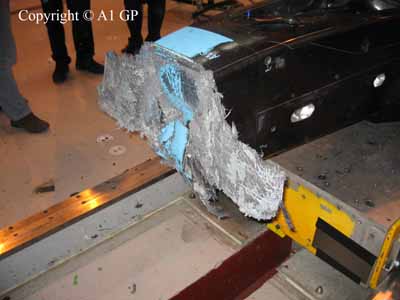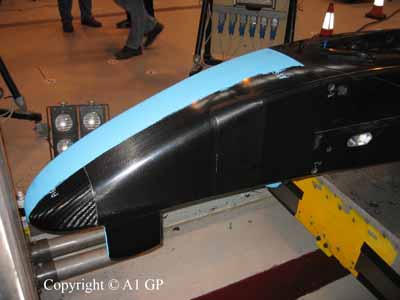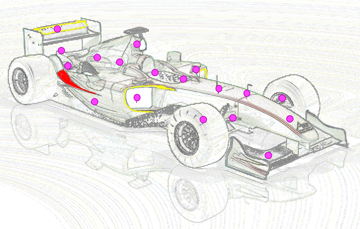A1GP Powered by Ferrari car passes crash test
Miroslav Sanytr├Īk | 25.8.08 | A1GP
London, Great Britain ŌĆō A1GP World Cup of Motorsport has always prided itself in the fact that its cars
are some of the safest on the worldŌĆÖs race tracks. Therefore, it should come as no surprise that the season four A1GP Powered
by Ferrari car has undergone and passed some of the most stringent crash tests possible.
The car firstly underwent FIA chassis squeeze tests, as opposed to a sudden impact test, with pressure applied to key parts of the car to ensure the necessary strength. Following this there have been roll-hoop load tests, front and rear impact and side impact tests.
The frontal impact test involves a head-on collision into a thick steel plate set in concrete. In such an impact, the nosecone in front of the pedals is allowed a small amount of deformation with no damage beyond the nosecone acceptable and with the deceleration of the car also measured to ensure the chassis, and therefore driver, would not be subjected to excessive g-force on impact.
Rear impact tests involve weights, the equivalent to a fully-fuelled A1GP car being hit into the back to test there would be no damage to the cockpit in a similar way to side impact tests where checks are done to ensure the cars can withstand pre-specified impacts and still leave the internal cockpit undamaged. Finally, a steering column impact test was also undertaken.
The tests were all carried out under the watchful eye of the F├®d├®ration Internationale de l"Automobile (FIA) and A1GP Technical Director, John Travis at the TRL, the UK"s Transport Research Laboratory, in Berkshire.
John Travis: ŌĆ£We did a lot of pre-tests on all the components in isolation and FEA (Finite Element Analysis) studies on the structural design of the chassis, before moving on to the physical tests. The car has now completed 5800-kilometres without problems so weŌĆÖre very happy with the progress. We have a small number of engine software issues to finalise but tyre testing is now complete and Michelin are ready and looking forward to a competitive season ahead.ŌĆØ
Dr Paul Trafford, A1GP Medical Delegate: ŌĆ£The first three seasons of A1GP have shown the cars to be remarkably safe, protecting the drivers and allowing them to survive some major impacts. The FIA have stringent crash testing requirements which are constantly being updated to ensure the ŌĆ£safety cellŌĆØ concept is advanced and improved each year as technology develops. The tub acts as a ŌĆ£safety cellŌĆØ around the driver to absorb energy in the event of an impact, prevent intrusion and injury and protect the head and other vital areas. The idea is that if a car is rolling or spinning it is losing the energy that is transferred to the driver when the car impacts another object. Deformable and crushable areas of the car such as the nosecone actually help reduce this energy further before it is experienced by the driver.
ŌĆ£I am delighted that A1GP has taken the safety of its drivers so seriously and has committed to ensuring the cars stay at the forefront of safety technology and are willing to listen to advice from medical experts and other industry experts in order to achieve this.ŌĆØ
|
|






